Bin Cui
Rethinking Text-to-SQL: Dynamic Multi-turn SQL Interaction for Real-world Database Exploration
Oct 30, 2025Abstract:Recent advances in Text-to-SQL have achieved strong results in static, single-turn tasks, where models generate SQL queries from natural language questions. However, these systems fall short in real-world interactive scenarios, where user intents evolve and queries must be refined over multiple turns. In applications such as finance and business analytics, users iteratively adjust query constraints or dimensions based on intermediate results. To evaluate such dynamic capabilities, we introduce DySQL-Bench, a benchmark assessing model performance under evolving user interactions. Unlike previous manually curated datasets, DySQL-Bench is built through an automated two-stage pipeline of task synthesis and verification. Structured tree representations derived from raw database tables guide LLM-based task generation, followed by interaction-oriented filtering and expert validation. Human evaluation confirms 100% correctness of the synthesized data. We further propose a multi-turn evaluation framework simulating realistic interactions among an LLM-simulated user, the model under test, and an executable database. The model must adapt its reasoning and SQL generation as user intents change. DySQL-Bench covers 13 domains across BIRD and Spider 2 databases, totaling 1,072 tasks. Even GPT-4o attains only 58.34% overall accuracy and 23.81% on the Pass@5 metric, underscoring the benchmark's difficulty. All code and data are released at https://github.com/Aurora-slz/Real-World-SQL-Bench .
PSEO: Optimizing Post-hoc Stacking Ensemble Through Hyperparameter Tuning
Aug 07, 2025Abstract:The Combined Algorithm Selection and Hyperparameter Optimization (CASH) problem is fundamental in Automated Machine Learning (AutoML). Inspired by the success of ensemble learning, recent AutoML systems construct post-hoc ensembles for final predictions rather than relying on the best single model. However, while most CASH methods conduct extensive searches for the optimal single model, they typically employ fixed strategies during the ensemble phase that fail to adapt to specific task characteristics. To tackle this issue, we propose PSEO, a framework for post-hoc stacking ensemble optimization. First, we conduct base model selection through binary quadratic programming, with a trade-off between diversity and performance. Furthermore, we introduce two mechanisms to fully realize the potential of multi-layer stacking. Finally, PSEO builds a hyperparameter space and searches for the optimal post-hoc ensemble strategy within it. Empirical results on 80 public datasets show that \sys achieves the best average test rank (2.96) among 16 methods, including post-hoc designs in recent AutoML systems and state-of-the-art ensemble learning methods.
PilotRL: Training Language Model Agents via Global Planning-Guided Progressive Reinforcement Learning
Aug 01, 2025Abstract:Large Language Models (LLMs) have shown remarkable advancements in tackling agent-oriented tasks. Despite their potential, existing work faces challenges when deploying LLMs in agent-based environments. The widely adopted agent paradigm ReAct centers on integrating single-step reasoning with immediate action execution, which limits its effectiveness in complex tasks requiring long-term strategic planning. Furthermore, the coordination between the planner and executor during problem-solving is also a critical factor to consider in agent design. Additionally, current approaches predominantly rely on supervised fine-tuning, which often leads models to memorize established task completion trajectories, thereby restricting their generalization ability when confronted with novel problem contexts. To address these challenges, we introduce an adaptive global plan-based agent paradigm AdaPlan, aiming to synergize high-level explicit guidance with execution to support effective long-horizon decision-making. Based on the proposed paradigm, we further put forward PilotRL, a global planning-guided training framework for LLM agents driven by progressive reinforcement learning. We first develop the model's ability to follow explicit guidance from global plans when addressing agent tasks. Subsequently, based on this foundation, we focus on optimizing the quality of generated plans. Finally, we conduct joint optimization of the model's planning and execution coordination. Experiments indicate that PilotRL could achieve state-of-the-art performances, with LLaMA3.1-8B-Instruct + PilotRL surpassing closed-sourced GPT-4o by 3.60%, while showing a more substantial gain of 55.78% comparing to GPT-4o-mini at a comparable parameter scale.
Learning What Reinforcement Learning Can't: Interleaved Online Fine-Tuning for Hardest Questions
Jun 09, 2025
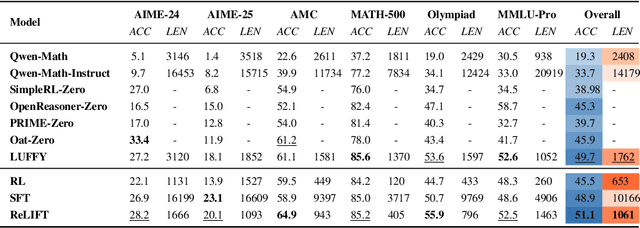
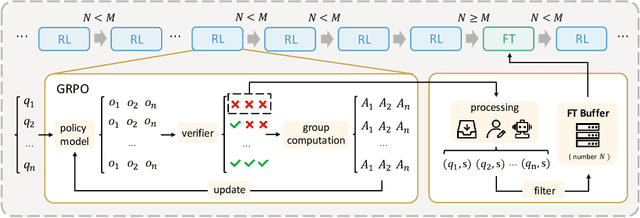

Abstract:Recent advances in large language model (LLM) reasoning have shown that sophisticated behaviors such as planning and self-reflection can emerge through reinforcement learning (RL). However, despite these successes, RL in its current form remains insufficient to induce capabilities that exceed the limitations of the base model, as it is primarily optimized based on existing knowledge of the model rather than facilitating the acquisition of new information. To address this limitation, we employ supervised fine-tuning (SFT) to learn what RL cannot, which enables the incorporation of new knowledge and reasoning patterns by leveraging high-quality demonstration data. We analyze the training dynamics of RL and SFT for LLM reasoning and find that RL excels at maintaining and improving performance on questions within the model's original capabilities, while SFT is more effective at enabling progress on questions beyond the current scope of the model. Motivated by the complementary strengths of RL and SFT, we introduce a novel training approach, \textbf{ReLIFT} (\textbf{Re}inforcement \textbf{L}earning \textbf{I}nterleaved with Online \textbf{F}ine-\textbf{T}uning). In ReLIFT, the model is primarily trained using RL, but when it encounters challenging questions, high-quality solutions are collected for fine-tuning, and the training process alternates between RL and fine-tuning to enhance the model's reasoning abilities. ReLIFT achieves an average improvement of over +5.2 points across five competition-level benchmarks and one out-of-distribution benchmark compared to other zero-RL models. Furthermore, we demonstrate that ReLIFT outperforms both RL and SFT while using only 13\% of the detailed demonstration data, highlighting its scalability. These results provide compelling evidence that ReLIFT overcomes the fundamental limitations of RL and underscores the significant potential.
LogicPuzzleRL: Cultivating Robust Mathematical Reasoning in LLMs via Reinforcement Learning
Jun 05, 2025Abstract:Large language models (LLMs) excel at many supervised tasks but often struggle with structured reasoning in unfamiliar settings. This discrepancy suggests that standard fine-tuning pipelines may instill narrow, domain-specific heuristics rather than fostering general-purpose thinking strategies. In this work, we propose a "play to learn" framework that fine-tunes LLMs through reinforcement learning on a suite of seven custom logic puzzles, each designed to cultivate distinct reasoning skills such as constraint propagation, spatial consistency, and symbolic deduction. Using a reinforcement learning setup with verifiable rewards, models receive binary feedback based on puzzle correctness, encouraging iterative, hypothesis-driven problem solving. We demonstrate that this training approach significantly improves out-of-distribution performance on a range of mathematical benchmarks, especially for mid-difficulty problems that require multi-step reasoning. Analyses across problem categories and difficulty levels reveal that puzzle training promotes transferable reasoning routines, strengthening algebraic manipulation, geometric inference, and combinatorial logic, while offering limited gains on rote or highly specialized tasks. These findings show that reinforcement learning over logic puzzles reshapes the internal reasoning of LLMs, enabling more robust and compositional generalization without relying on task-specific symbolic tools.
SALE : Low-bit Estimation for Efficient Sparse Attention in Long-context LLM Prefilling
May 30, 2025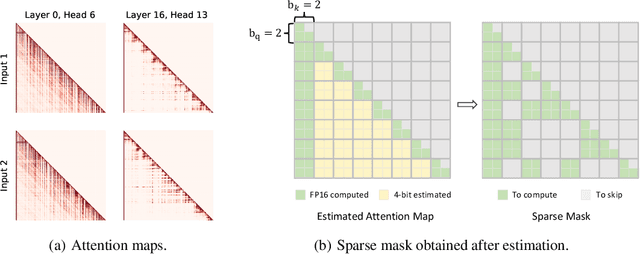
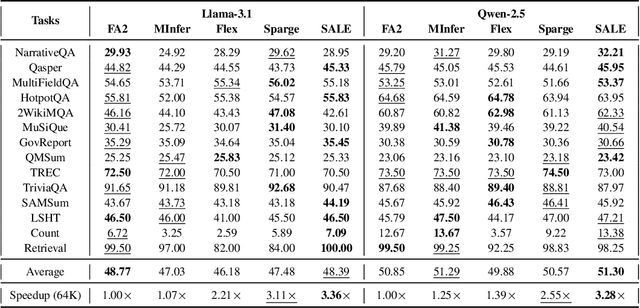

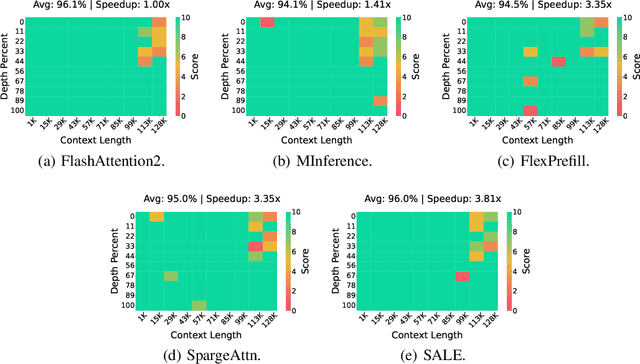
Abstract:Many advanced Large Language Model (LLM) applications require long-context processing, but the self-attention module becomes a bottleneck during the prefilling stage of inference due to its quadratic time complexity with respect to sequence length. Existing sparse attention methods accelerate attention computation by skipping less significant regions of the attention map. However, these approaches typically perform coarse-grained inspection of the attention map, rendering considerable loss in model accuracy. In this paper, we propose SALE, a fine-grained sparse attention method that accelerates the long-context prefilling stage of LLM with negligible loss in model accuracy. SALE achieves fast and accurate fine-grained attention weight estimation through 4-bit quantized query-key products, followed by block-sparse attention to accelerate prefilling computations. For importance evaluation for query-key pairs, we adopt our Relative Attention Score metric, which offers significantly higher efficiency within our framework. We implement a custom CUDA kernel optimized for our approach for hardware efficiency, reducing the additional overhead to approximately 11% of the full attention latency. Notably, SALE requires no parameter training and can be seamlessly integrated into existing systems with trivial code modifications. Experiments on long-context benchmarks demonstrate that our method outperforms existing approaches in accuracy-efficiency trade-offs, achieving at least 3.36x speedups on Llama-3.1-8B for sequences longer than 64K while maintaining model quality.
LoVR: A Benchmark for Long Video Retrieval in Multimodal Contexts
May 20, 2025Abstract:Long videos contain a vast amount of information, making video-text retrieval an essential and challenging task in multimodal learning. However, existing benchmarks suffer from limited video duration, low-quality captions, and coarse annotation granularity, which hinder the evaluation of advanced video-text retrieval methods. To address these limitations, we introduce LoVR, a benchmark specifically designed for long video-text retrieval. LoVR contains 467 long videos and over 40,804 fine-grained clips with high-quality captions. To overcome the issue of poor machine-generated annotations, we propose an efficient caption generation framework that integrates VLM automatic generation, caption quality scoring, and dynamic refinement. This pipeline improves annotation accuracy while maintaining scalability. Furthermore, we introduce a semantic fusion method to generate coherent full-video captions without losing important contextual information. Our benchmark introduces longer videos, more detailed captions, and a larger-scale dataset, presenting new challenges for video understanding and retrieval. Extensive experiments on various advanced embedding models demonstrate that LoVR is a challenging benchmark, revealing the limitations of current approaches and providing valuable insights for future research. We release the code and dataset link at https://github.com/TechNomad-ds/LoVR-benchmark
Let's Verify Math Questions Step by Step
May 20, 2025Abstract:Large Language Models (LLMs) have recently achieved remarkable progress in mathematical reasoning. To enable such capabilities, many existing works distill strong reasoning models into long chains of thought or design algorithms to construct high-quality math QA data for training. However, these efforts primarily focus on generating correct reasoning paths and answers, while largely overlooking the validity of the questions themselves. In this work, we propose Math Question Verification (MathQ-Verify), a novel five-stage pipeline designed to rigorously filter ill-posed or under-specified math problems. MathQ-Verify first performs format-level validation to remove redundant instructions and ensure that each question is syntactically well-formed. It then formalizes each question, decomposes it into atomic conditions, and verifies them against mathematical definitions. Next, it detects logical contradictions among these conditions, followed by a goal-oriented completeness check to ensure the question provides sufficient information for solving. To evaluate this task, we use existing benchmarks along with an additional dataset we construct, containing 2,147 math questions with diverse error types, each manually double-validated. Experiments show that MathQ-Verify achieves state-of-the-art performance across multiple benchmarks, improving the F1 score by up to 25 percentage points over the direct verification baseline. It further attains approximately 90% precision and 63% recall through a lightweight model voting scheme. MathQ-Verify offers a scalable and accurate solution for curating reliable mathematical datasets, reducing label noise and avoiding unnecessary computation on invalid questions. Our code and data are available at https://github.com/scuuy/MathQ-Verify.
Thinking Short and Right Over Thinking Long: Serving LLM Reasoning Efficiently and Accurately
May 19, 2025Abstract:Recent advances in test-time scaling suggest that Large Language Models (LLMs) can gain better capabilities by generating Chain-of-Thought reasoning (analogous to human thinking) to respond a given request, and meanwhile exploring more reasoning branches (i.e., generating multiple responses and ensembling them) can improve the final output quality. However, when incorporating the two scaling dimensions, we find that the system efficiency is dampened significantly for two reasons. Firstly, the time cost to generate the final output increases substantially as many reasoning branches would be trapped in the over-thinking dilemma, producing excessively long responses. Secondly, generating multiple reasoning branches for each request increases memory consumption, which is unsuitable for LLM serving since we can only batch a limited number of requests to process simultaneously. To address this, we present SART, a serving framework for efficient and accurate LLM reasoning. The essential idea is to manage the thinking to be short and right, rather than long. For one thing, we devise a redundant sampling with early stopping approach based on empirical observations and theoretic analysis, which increases the likelihood of obtaining short-thinking responses when sampling reasoning branches. For another, we propose to dynamically prune low-quality branches so that only right-thinking branches are maintained, reducing the memory consumption and allowing us to batch more requests. Experimental results demonstrate that SART not only improves the accuracy of LLM reasoning but also enhances the serving efficiency, outperforming existing methods by up to 28.2 times and on average 15.7 times in terms of efficiency when achieving the same level of accuracy.
SAS-Bench: A Fine-Grained Benchmark for Evaluating Short Answer Scoring with Large Language Models
May 15, 2025Abstract:Subjective Answer Grading (SAG) plays a crucial role in education, standardized testing, and automated assessment systems, particularly for evaluating short-form responses in Short Answer Scoring (SAS). However, existing approaches often produce coarse-grained scores and lack detailed reasoning. Although large language models (LLMs) have demonstrated potential as zero-shot evaluators, they remain susceptible to bias, inconsistencies with human judgment, and limited transparency in scoring decisions. To overcome these limitations, we introduce SAS-Bench, a benchmark specifically designed for LLM-based SAS tasks. SAS-Bench provides fine-grained, step-wise scoring, expert-annotated error categories, and a diverse range of question types derived from real-world subject-specific exams. This benchmark facilitates detailed evaluation of model reasoning processes and explainability. We also release an open-source dataset containing 1,030 questions and 4,109 student responses, each annotated by domain experts. Furthermore, we conduct comprehensive experiments with various LLMs, identifying major challenges in scoring science-related questions and highlighting the effectiveness of few-shot prompting in improving scoring accuracy. Our work offers valuable insights into the development of more robust, fair, and educationally meaningful LLM-based evaluation systems.
 Add to Chrome
Add to Chrome Add to Firefox
Add to Firefox Add to Edge
Add to Edge